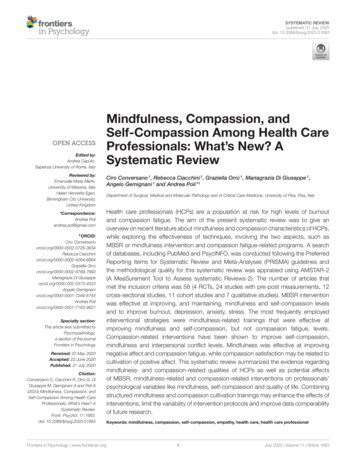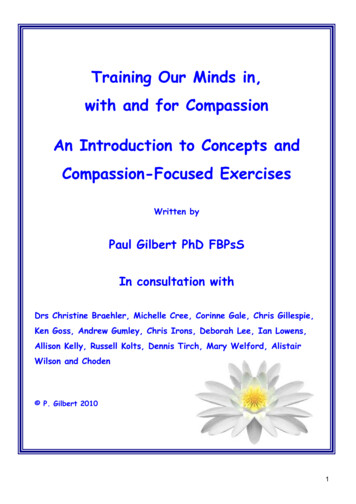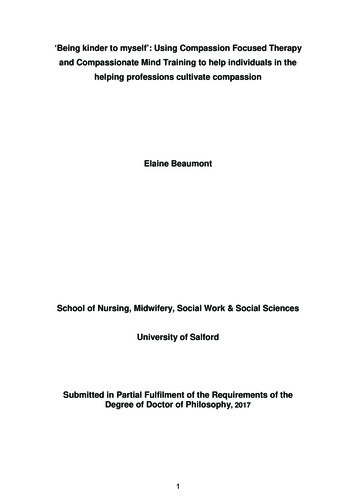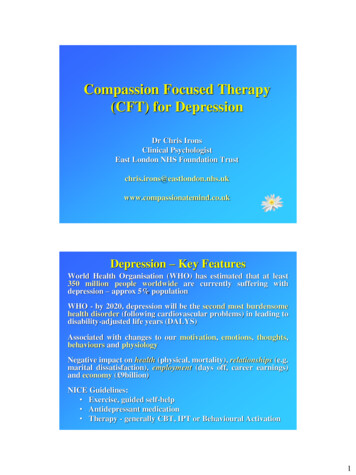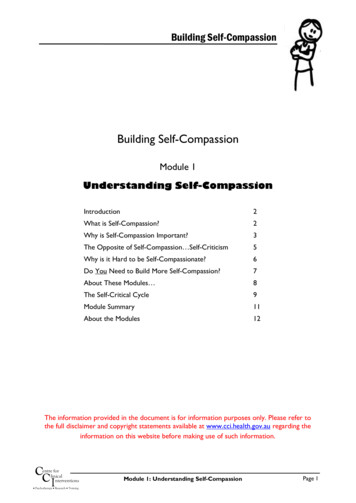
Transcription
Building Self-CompassionBuilding Self-CompassionBuilding Self-CompassionModule 1Understanding Self-CompassionIntroduction2What is Self-Compassion?2Why is Self-Compassion Important?3The Opposite of Self-Compassion Self-Criticism5Why is it Hard to be Self-Compassionate?6Do You Need to Build More Self-Compassion?7About These Modules 8The Self-Critical Cycle9Module Summary11About the Modules12The information provided in the document is for information purposes only. Please refer tothe full disclaimer and copyright statements available at www.cci.health.gov.au regarding theinformation on this website before making use of such information.forCentrelinicalC Interventions Psychotherapy Research TrainingModule 1: Understanding Self-CompassionPage 1
IntroductionBuilding Self-CompassionThe old saying goes that, “You are your own worst critic”. It is very true that most of us are hard onourselves, particularly if we get even the slightest hint that we don’t ‘match up’ in some way – in ourachievements, career or study, social standing, relationships, appearance, body image, financial status, etc. Ifwe make even the minutest mistake, then we have a tendency to berate ourselves, and if we make agenuine medium or large mistake, then look out!People seem to find it hard, and for some almost impossible, to treat or speak to themselves in a kind orcaring manner. In fact, some recoil from the idea of it, like they were being asked to do somethingrepulsive or painful. In this module we will look at what self-compassion is all about, why it is so vital toour well-being, and why we are great at self-criticism, but struggle when it comes to self-kindness.Being able to cultivate self-compassion can be a stand-alone approach that mightaddress all your mental health needs, or it may be a helpful starting point to then goon and address more specific issues that are covered in our other Infopax. Eitherway, if you identify with being your own harshest critic, then join us on the journeyfrom self-criticism to self-kindness What is Self-Compassion?To define self-compassion, we really need to start with what is compassion. The two are really one and thesame. Compassion is an attitude that involves a certain set of feelings, thoughts, motives, desires, urges,and behaviours that can be directed towards any living thing (i.e., ourselves, another person, a group ofpeople, a society, animals, the environment, etc.). Therefore, when we talk about self-compassion, we arespecifying that this attitude is being directed internally towards ourselves.Paul Gilbert and Kristen Neff are two leading figures in the area of building self-compassion to improvemental health and well-being, and these modules draw heavily on their expertise and writing.Kristen Neff defines compassion as:“the recognition and clear seeing of suffering feelings of kindness for people who are suffering, so that thedesire to help – to ameliorate suffering – emerges recognizing our shared human condition, flawed andfragile as it is” (Neff, 2011, p10)Similarly, Paul Gilbert defines compassion as:“a basic kindness, with a deep awareness of the suffering of oneself and of other living things, coupled withthe wish and effort to relieve it” (Gilbert, 2009, p. xiii)You will notice that these definitions emphasise four key things:1. Awareness. Being attentive or sensitive to the fact that some sort of ‘suffering’ is occurring. Nowsuffering could mean some distressing struggle with emotional pain, mental pain, physical pain, or allof the above.2. Normalising. Recognising that experiencing this sort of pain is universal, we all experience pain atsome point to varying degrees. The fact that we experience pain isn’t a fault or failing of ours, weare not to blame for our pain, and we are not alone in our pain.3. Kindness. Not shying away from or ignoring the pain, but meeting this pain with feelings ofkindness, care, warmth and concern.4. Alleviation. Focusing our energy on ways to alleviate the pain, which may be via providing furthercomfort and caring actions, providing a helpful perspective regarding whatever the trouble is, orhaving the strength and courage to take other necessary actions to address the problem beingfaced.forCentrelinicalC Interventions Psychotherapy Research TrainingModule 1: Understanding Self-CompassionPage 2
Building Self-CompassionSo self-compassion is about doing all of these four things for ourselves when we are struggling. That is,being aware of our own pain, whatever that may be. Understanding that whilst feeling this pain is hard, thisis a normal human experience, not a failing on our part and we are not alone. It then involves directingfeelings of kindness and care towards ourselves, just as we might to someone else we care about who isstruggling. And finally, focusing our attention and energy on how we might improve our own pain andmove through the struggle we are facing.You may think, well that all sounds very nice, but how exactly do I do that? The modules to come will helpyou develop the ability to take a deeply caring attitude towards yourself, particularly in times of struggle.Being self-compassionate is a skill that initially takes a lot of effort, so before we get to the ‘nuts and bolts’of how to be more self-compassionate, let’s first think about why it would be worth the effort.Why is Self-Compassion Important?Evolutionary ImportanceThe need to receive care and nurturing evolved as a strong need within all mammals, including humans.Being cared for from birth is vital to our survival, and without it we don’t thrive. The success of the humanrace as a species has depended on us receiving care and being motivated to give care to others. When thisis working well, humans work together, supporting each other and flourishing. Whilst receiving care fromother people is of course very important, we now know that it is very narrow to think that we can onlyfulfil this need for care through other people. Fulfilling our need for care and nurture ourselves, can also beextremely valuable.Mental Health and Well Being BenefitsResearch has shown that self-compassion is strongly linked to our mental health and well-being. Studieshave found that those who are more compassionate towards themselves tend to have less mental healthproblems, like depression, anxiety and stress. These people also tend to have a better quality of life, agreater sense of well-being, and less problems in relationships. Compassion is linked to the hormoneoxytocin, often called the “love” hormone. This is a hormone that promotes bonding and closeness, andtherefore is particularly active at childbirth, during physical affection, during sex, when parents play withtheir children, when people play with their pets, etc. It is suggested that directing compassion inwards canequally trigger the release of oxytocin, and the calming benefits it brings. In essence, self-compassion goeshand in hand with general life contentment, something we could all do with a dose of.Balancing Our EmotionsThe reason why self-compassion might bring us such wonderful benefits, is via its proposed vital role inhelping to balance our emotions. Paul Gilbert has written extensively about the idea that our emotions aregoverned by three systems known as the threat, drive and soothe systems, with each playing animportant role in regulating our emotions.Threat: Generally speaking all living creatures are good at anticipating and avoidingthreat in order to survive. This protective mechanism is hard wired within us all.Couple this with the human ability to think a lot, and we find that the human mindseems to have a default setting to look for, pay attention to and repetitively think aboutbad stuff. This results in our threat system being active and in overdrive a lot.No longer are we in caveman times where the presence of a sabre tooth tiger is the type of thing thattriggers our threat system. In today’s society, small mistakes or perceived flaws in our abilities, appearance,social skills, etc, are all seen as threats. These sorts of things are seen as risks to our reputation, socialstatus, relationships, career, finances, health, future or happiness. So our threat system seems to be on highalert for many of us most of the time, always on the lookout for potential dangers in order to protectourselves.forCentrelinicalC Interventions Psychotherapy Research TrainingModule 1: Understanding Self-CompassionPage 3
Building Self-CompassionWhen active the threat system leads to emotional responses such as anxiety, anger, or depression. Theseemotions are all about motivating us to protect ourselves, with anger prompting us to confront and defeatdanger, anxiety prompting us to shy away from danger, and depression prompting us to shut down fromdanger. As such, the threat system also generates corresponding behavioural responses such as to ‘fight’(i.e., aggression), ‘flight’ (i.e., avoidance) or ‘freeze’ (i.e., being submissive or passive).When we are in threat mode our thinking becomes very narrow and negative. Our mind doesn’t seem tobudge easily from its narrow negative focus when it is in this state. It is very difficult to think in balanced,reasonable, rationale ways when in threat mode, as this requires quite sophisticated thinking by our brain.Our brain wasn’t designed to be sophisticated when it thinks we are in danger. Sophisticated thinking takesup time, something you have little of if you really are in danger. By contrast, narrow negative thinking isvery quick. This is really important to know, as people often berate themselves for their seemingly‘irrational’ thinking when they are experiencing distressing emotions, not realising that essentially their mindwas built to be irrational when it senses danger.Now the threat system is not a bad thing. Remember, its purpose is to keep us safe from legitimate threats(e.g., getting out of the way of a moving car). However, many of our mental health problems relate to thethreat system being active too much of the time when there is no real danger.Drive: The drive system spurs us on to try new things, achieve things, set and worktowards goals, and feel those ecstatic ‘high five moments’ when we have those ‘wins’ inlife. The drive system is what energises us to get things done and be active in life.Having ‘drive’ is great, because it keeps us progressing in life. Without our drive systembeing active some of the time, we would be rather lifeless and directionless, a problemthat can occur when we feel depressed.The problem is that this system, like the threat system, can also kick into overdrive. This particularlyhappens if we live in a society that is highly competitive, and gives us the message that we always need todo more and be better, and if we don’t achieve this then there is something wrong with us. What canhappen is that when we don’t succeed in our goals, which understandably is not always possible to do, thenwe can quickly flip from the drive system into the threat system. And so, we can become trapped in anunhealthy pattern of drive, drive, drive (e.g., “I must achieve, achieve, achieve”), and when we hit a barrierthen it is threat, threat, threat (e.g., “I’ve failed and so now lots of bad stuff is going to happen to me”).Soothe: The soothe system is very different, and has a calming influence on both the threat and drivesystems, helping to quieten them down when they are overactive. The soothe system is at work when weare just chilling out, feeling safe, calm and content. You can’t be in threat and soothe mode at the sametime, and you can’t be in drive and soothe mood at the same time.Experiences of kindness and care tend to stimulate the soothe system. Whilst receiving compassion fromothers is one way to unlock the soothe system, self-compassion is another key. These modules are reallyabout finding this key and using it whenever we need to calm the threat and drive systems, by bringing thesoothe system online to balance our emotions.ThreatSelfCompassionSOOTHEDriveAdapted from Gilbert (2010)forCentrelinicalC Interventions Psychotherapy Research TrainingModule 1: Understanding Self-CompassionPage 4
Building Self-CompassionThe Opposite of Self-Compassion Self-CriticismFor most people, being compassionate towards themselves and therefore activating thesoothe system doesn’t come naturally. However the opposite of self-compassion, selfcriticism, seems to very easily roll off the tongue. Self-criticism is a thinking style thatinvolves our internal self-talk being highly negative, disparaging and berating. Selfcriticism can therefore activate the threat system in and of itself, or once the threatsystem is active for other reasons, responding by being critical of ourselves can keep thethreat system alive.The content of self-critical thoughts can be very cruel and the tone very cold, harsh, and attacking. It is likewe are telling off or reprimanding ourselves in a most unkind or punishing way. This thinking style occurswithin us all to varying degrees, and is very common in our society. You will tend to hear most peoplerefer to themselves as “stupid” or “idiot” when they make a small mistake. This may be at the milder endof self-criticism. Others may routinely speak to themselves harshly, while others may frequently hurl abarrage of abuse at themselves. Some harsh self-critics may experience a sense of self-loathing, self-hatredor self-disgust, where they believe they don’t deserve to treat themselves any better.Some common examples of self-critical statements might sound something like:I am an idiot what a moron you are useless and pathetic I am so hopeless You shouldn’t have done that .why did I do that you should have known better I never get it right you may as well give up now there is no point, why bother You will notice that some self-critics refer to themselves in the first person (I am ), whilst others mayrefer to themselves using a second person perspective (you are ). You
Paul Gilbert and Kristen Neff are two leading figures in the area of building self-compassion to improve mental health and well-being, and these modules draw heavily on their expertise and writing. Kristen Neff defines compassion as: “the recognition and clear seeing of suffering feelings of kindness for people who are suffering, so that the desire to help – to ameliorate suffering .
